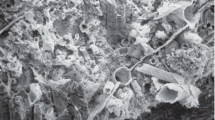Abstract
THE ability of microorganisms such as bacteria and fungi to concentrate uranium and other metals from solution has long been recognized (see, for example, refs 1–10), and has previously been applied to the economic recovery of metals from natural and industrial waste waters10–13. This phenomenon is also important in the risk assessment of radioactive waste disposal, as the mobility of microbes may either enhance or retard radionuclide migration14. Although microbiological activity has been thought to influence the deposition or remobilization of uranium in natural deposits15,16, there have been only a few direct observations of naturally mineralized microbial structures17,18. During recent investigations of uranium mobilization from mineralized rocks in southwest Scotland, we observed the presence of uranium-mineral-ized structures attributable to the activity of filamentous microor-ganisms. Unlike previous accounts of either artificially stained1,3,6,19 or naturally mineralized microbes17,18, the structures we describe display polymetallic mineralization, with a complex relationship between the metal species concentrated and its location in the microorganism.
Similar content being viewed by others
References
Beveridge, T. J. & Murray, R. G. E. J. Bact. 127, 1502–1518 (1976).
Hawker, L. E. & Linton, A. H. Microorganisms (Arnold, London, 1979).
Beveridge, T. J. & Murray, R. G. E. J. Bact. 141, 876–887 (1980).
Doyle, R. J., Matthews, T. H. & Streips, U. N. J. Bact. 143, 471–480 (1980).
Disnar, J-R., Geochim. cosmochim. Acta 45, 363–379 (1981).
Beveridge, T. J., Meloche, J. D., Fyfe, W. S. & Murray, R. G. E. Appl. envir. Microbiol. 45, 1094–1108 (1983).
Ferris, F. G. & Beveridge, T. J. Bioscience 35, 172–177 (1985).
Beveridge, T. J. Biotechnol. Bioengng Symp. 16, 127–139 (1986).
Nakajima, A. & Sakaguchi, T. Appl. Microbiol. Biotechnol. 24, 59–64 (1986).
Eccles, H. & Hunt, S. Immobilisation of Ions by Bio-Sorption (Ellis Horwood, London, 1986).
Horikoshi, T., Nakajima, A. & Skaguchi, T. J. Fermentation Technol. 57, 191–194 (1979).
Lorenz, M. G. & Krumbein, W. E. Appl. Microbiol. Biotechnol. 21, 374–377 (1985).
Volesky, B. Biotechnol. Bioengng Symp. 16, 121–126 (1986).
West, J. M., McKinley, I. G. & Chapman, N. A. Radioactive Waste Management Nucl. Fuel Cycle 3, 1–15 (1982).
Magne, R., Berthelin, J. R. & Dommergues, Y. Proc. Symp. Formation of Uranium Ore Deposits, 73–88 (IAEA, Vienna, 1974).
Landais, P. Terra Nova 1, 163–171 (1989).
Capus, G. & Munier, C. C.r. hebd. Séanc. Acad. Sci., Paris 287, 191–194 (1978).
Degens, E. T. & Venugopalen, I. Nature 298, 262–264 (1982).
Beveridge, T. J. & Fyfe, W. S. Can. J. Earth Sci. 22, 1893–1898 (1985).
Halliday, A. N., Stephens, W. E. & Harmon, R. S. J. geol. Soc. Lond. 137, 329–348 (1980).
Miller, J. M. & Taylor, K. Bull. Geol. Surv. G.B. 25, 1–18 (1966).
Basham, I. R., Milodowski, A. E., Hyslop, E. K. & Pearce, J. M. Brit. geol. Surv. Fluid Processes Research Group Tech. Rep. WE/89/56 (Brit. geol. Surv., Keyworth, 1989).
Roberts, P. D., Ball, T. K., Hooker, P. J. & Milodowski, A. E. Mater. Res. Soc. Symp. Proc. 127 (eds Lutze, W. & Ewing, R. C.) 933–940 (MRS, Pittsburgh, 1989).
Côme, B. & Chapman, N. A. (eds) Natural Analogue Working Group, Rep. CEC EUR 10315-EN (CEC, Luxembourg, 1986).
Basham, I. R. Econ. Geol. 76, 994–997 (1981).
Kleeman, J. D. & Lovering, J. F. Atom. Energy Aust., 10, 3–8 (1967).
Basham, I. R., Ball, T. K., Beddoe-Stephens, B. & Michie, U. McL. Proc. Symp. Uranium Exploration Methods 385–397 (OECD/NEA, Paris, 1982).
Braithwaite, R. S. W. & Knight, J. R. Miner. Mag. 54, 129–131 (1990).
Parnell, J. Uranium 4, 197–218 (1988).
Eakin, P. A. J. geol. Soc. Lond. 146, 663–673 (1989).
Buchanan, R. E. & Gibbons, N. E. (eds) Bergey's Manual of Determinative Bacteriology. 8th edn (Williams & Wilkins, Baltimore, 1975).
Palache, C., Berman, H. & Frondel, C. Dana's System of Mineralogy, Vol. 2 (Wiley, New York, 1951).
James, A. M. Chem. Soc. Rev. 8, 389–418 (1979).
James, A. M. Adv. Colloid Interface Sci. 15, 171–211 (1982).
Author information
Authors and Affiliations
Rights and permissions
About this article
Cite this article
Milodowski, A., West, J., Pearce, J. et al. Uranium-mineralized micro-organisms associated with uraniferous hydrocarbons in southwest Scotland. Nature 347, 465–467 (1990). https://doi.org/10.1038/347465a0
Received:
Accepted:
Issue Date:
DOI: https://doi.org/10.1038/347465a0
- Springer Nature Limited
This article is cited by
-
Lipid Evidence for Oil Depletion by Sulfate-Reducing Bacteria during U Mineralization in the Dongsheng Deposit
Journal of Earth Science (2018)
-
Biogeochemical behaviour and bioremediation of uranium in waters of abandoned mines
Environmental Science and Pollution Research (2013)
-
Lipids of sulfate-reducing bacteria and sulfur-oxidizing bacteria found in the Dongsheng uranium deposit
Chinese Science Bulletin (2012)
-
The development of Fe-nodules surrounding biological material mediated by microorganisms
Environmental Geology (2008)
-
REE/trace element characteristics of sandstone-type uranium deposits in the Ordos Basin
Chinese Journal of Geochemistry (2006)





